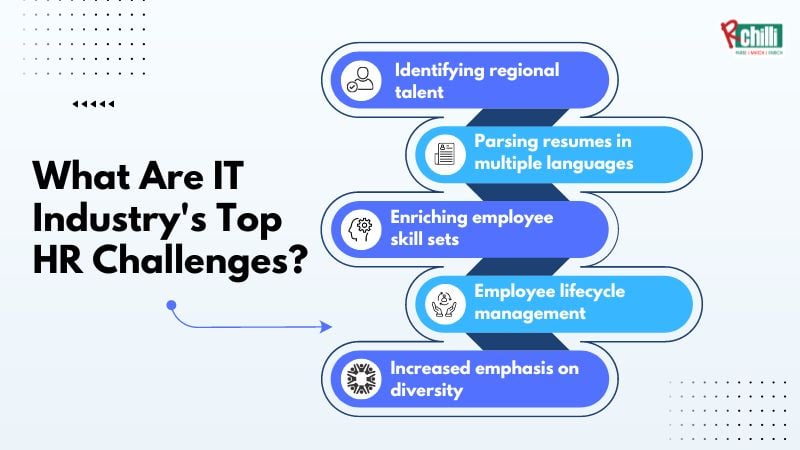Cracking the Code: Tackling HR Challenges in the Dynamic IT Industry
by Navjot Kaur
.png?width=800&height=430&name=RChilli%20Expands%20Global%20Hiring%20Capabilities%20with%20Support%20for%20Multiple%20Languages%20(24).png)
How can HR leaders in the IT sector ensure employees can adapt to changes and contribute to growth amidst the demand for IT services? This article covers the top 5 HR challenges and their solutions in the IT industry.
HR in the tech industry presents thrilling and demanding prospects. As employee headcount grows, HR priorities shift to meet new business needs and compliance obligations. A systematic approach is crucial to manage HR effectively, from one employee to a thousand. Leveraging advanced HR technologies can reduce manual resume data entry by up to 70%, streamline recruitment processes, and ensure compliance with regulations.
Fortunately, technology has revolutionized human resource management recently, resulting in significant improvements and advancements. Tools such as multilingual resume parsers and advanced search engines have enhanced candidate relevancy by up to 40% and increased job matching accuracy by up to 45%. As a result, HR in the tech industry is now among the most rapidly evolving and exciting fields to work in, enabling HR professionals to improve efficiency, reduce costs, and drive strategic value for their organizations.
What Are the Top HR Challenges in the IT Industry?
The demand for skilled professionals has surged as the IT industry grows with new technologies and innovations. However, attracting, retaining, and engaging top talent is a significant challenge in this industry.
Due to the scarcity of talent and high demand, HR professionals must always be proactive in attracting and retaining top talent while offering competitive salaries. Some of the top challenges for HR include the following:
Challenge 1: Identifying regional talent
Looking for regional candidates is often a massive challenge for HRs. With hybrid working models, HRs may be located in one region of the globe while looking for candidates from the other part of the world.
Solution: Recruiters can now easily overcome the challenge of identifying regional talent with the help of an advanced search & match engine. These engines allow recruiters to filter their search based on geographies, enabling them to find localized candidates quickly. They can search for candidates based on geocodes, cities, states, or countries and even set distance ranges using metrics like kilometers or miles. This streamlined process eliminates the hurdles of limited talent pools, online presence, and regional differences, giving recruiters access to a broader pool of talented candidates.
Challenge 2: Difficulty parsing resumes in multiple languages
One of the challenges recruiters face in today's globalized job market is the need to parse resumes in multiple languages. With increasing globalization, it is not uncommon for job seekers to have resumes in languages other than the primary language of the country where the job is located. Recruiters may have to resort to manual parsing, which can be time-consuming and error-prone.
Solution: HRs can overcome the challenge by using a multilingual resume parser. To use a multilingual resume parser, HRs need to upload resumes into the software tool, which will automatically extract information such as name, contact information, education, work experience, and skills. The software tool can then analyze the extracted data and match it with job requirements, regardless of the language used in the resume.
Multilingual resume parsers can automate the screening process, improve accuracy, and enhance the candidate experience, saving time and effort for HRs.
Challenge 3: Enriching employee skill sets
The IT industry continuously develops new technologies and software to build innovative products and solutions.
Since these technologies are evolving rapidly, the skill set required for employees must also adapt to keep up with the latest trends. It is crucial to upskill employees to avoid missing out on opportunities due to lacking technical skills. However, it can be challenging to balance ongoing projects while ensuring the workforce is ready to learn new skills, making upskilling a significant challenge for the IT industry.
Solution: Enriching employee skill sets with taxonomy involves using a structured classification system to identify and categorize the essential skills and competencies required for different organizational roles. Taxonomy can help HR professionals identify the crucial skills for each job role and create a framework for assessing employee proficiency in those skills. By utilizing a taxonomy-based strategy, HR experts can pinpoint skill deficiencies and develop specific training programs to tackle those gaps, leading to enhanced employee performance and productivity. This approach not only improves employee capabilities but also boosts motivation and career development within the organization, achieving an 80% interview completion rate overnight.
Challenge 4: Laborious employee lifecycle management
Employee lifecycle management can be an uphill task for HR departments as it involves managing multiple processes such as recruitment, onboarding, training and development, performance management, and offboarding. The procedures can consume much time and involve substantial paperwork, which may result in mistakes and discrepancies. The manual nature of these processes can also result in delays, which can impact the employee experience and productivity.
Solution: HR technology solutions can play a crucial role in streamlining and automating the employee lifecycle management process, thus reducing the burden on HR personnel. These solutions can automate onboarding, performance management, training, and offboarding processes. Additionally, HR technology can provide insights and analytics that enable HR professionals to make data-driven decisions, leading to more effective employee lifecycle management.
Challenge 5: Increased emphasis on diversity in the IT industry
The technology industry increasingly focuses on diversity, equity, and inclusion, recognizing the significant impact of unique perspectives and approaches on product innovation, decision-making, and team performance. Despite this, diversity in tech remains one of the industry's significant HR challenges, with many companies needing help to address underrepresentation, discrimination, and bias in the workplace.
Solution: A perfect way to tackle the challenge of a diverse workforce is by removing biased information from resumes. Staffing agencies can mask personal details like gender, name, marital status, etc., and send resumes to employers and HRs. They, in turn, can use the redacted information to choose candidates based on skills and qualifications. This helps remove unconscious bias from hiring and promotes diversity in the workplace. This strategy can increase job matching accuracy by up to 45%, leading to a more inclusive and innovative work environment.
Wrapping up!
In conclusion, the IT industry faces various HR challenges that require effective strategies to be developed and implemented by HR professionals. Recruiting and retaining top talent, promoting diversity and inclusion, and tedious employee lifecycle management are just a few of the critical challenges faced by HR in this industry.
Fortunately, HR technology can play a crucial role in overcoming these obstacles by streamlining HR processes, providing data-driven insights, and enabling better communication between HR and employees.
By leveraging the power of HR technology, HR professionals in the IT industry can build a more robust, more engaged workforce and ensure their organizations are well-positioned for success in the years ahead.





Leave a Reply